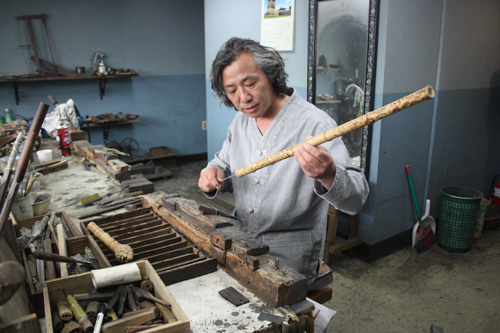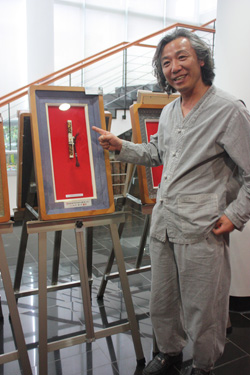중요무형문화재 제59호 박용기 장도장
Jangdo Makes You Feel the Breath of History
ByHwang In-sik, Cub-Reporter
We often see a lady protecting herself with a small knife in Korean historical dramas. In the past, women had a small knife in order to protect their own virginity, and men gave it to a king or a foreign envoy as a valuable gift to represent their position and to show off wealth and influence as well. This kind of knife is called Jangdo, a small, encased ornamental knife. Sadaebu, the gentry of the Joseon Dynastyperiod, always carried the small knife because it was a long standing custom among the Korean people.


The precious cultural property of making Jangdo has been passed down through generations of artisans. Park Yong-gi, who was designated as Important Intangible Cultural Property No.59 in 1978, handed down the knowledge to make Jangdo and preserve our ancestors’ wisdom and spirit to his son, Park Jong-gun. In the tradition of Confucianism, carrying an encased ornamental knife represents moral values such as patriotism, filial duty and loyalty. In the modern world, however, many people have forgotten the cultural tradition of the knife. “A few financial opportunities were the main reason why my mother opposed my plan to learn the art of Jangdo. I would not have done this work if my determination was just for money,” says Park Jung-gun.
People occasionally killed themselves in order to protect their beliefs in ancient Korea. Engraving designs such as letters and flowers on the knife meant ‘unchanging mind’ and faithfulness. For scholars, it has the symbolic meaning ‘loyalty to the king’, and for married women it meant chastity. Like these, Jangdo became part of the lives of Koreans—more than just a weapon, it represents the unbending spirit of the cultural symbolic icon of the Korean people.


So how is this valuable handicraft made? The production of Jangdo requires a lot of effort. First, you must make a square borae (metal bar) using steel which is approximately the shape of a knife. Next, silver is melted in a fire pot to expand its length and height to make different parts of the knife. It requires strong hands to resist the heat from the pot and powerful arms to strike with a hammer. Then the silver is cut and covered with native borax to protect the silver. It is then soldered in different parts and molded into a decorative form which is inserted into a wooden handle and sheath. Lastly, words are inscribed in the blade. Each process of making the knife needs to be done carefully and meticulously.
After interviewing the artisan, I thought that he was trying his best to preserve the art of Jangdo making. As his father devoted his whole life to preserving cultural traditions, he has made and effort to get Jangdo internationally recognised so the world can learn about the beauty of Jangdo. “If we don’t try to protect our culture, what will become of it?” said the artisan. Unlike our ancestors who struggled to preserve Korean culture when the Japanese imperialists instituted a policy to obliterate it, now many people do not have the slightest interest in our own traditional culture. We should pay more attention to our great history and cultural heritages.
황인식 수습기자
dlstlr58@nate.com

